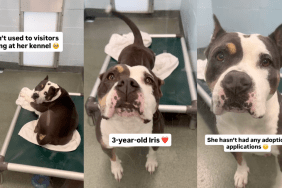by Leslie Smith, DogTime editor
June, 2010
Down the road from the animal shelter sits Santa Fe’s only enclosed dog park. A huge expanse on several acres, it features a small gated holding pen which walkers must pass through before entering the main run.
Monday morning, a friend of mine arrived at the park with her own dog, but instead of the usual early risers, she’d found a frightened Rottie mix standing alone in the holding pen.
There’s no way a dog can get in or out of that pen on his own, so with no human in sight, it was clear he’d been left there intentionally. The dog gazed expectantly out at the parking lot. His eyes darted from one side to the other, searching for the owner he’d witnessed drive away.
My friend sat with the dog inside the pen, hoping a person would appear and explain the whole thing had been a misunderstanding. But no one ever materialized. Finally, she called Animal Control, and waited with the dog until an officer arrived.
As law requires, the Rottie was still being held as a stray when I showed up for my Tuesday shift. Like all strays, the dog must wait a five day “stray period” before he is officially property of the county; during this wait time, volunteers can’t legally walk him (or any stray). So, I sat outside the big dog’s kennel as long as I could, hoping to help him feel less alone.
He was still there on Friday when I came for my next shift. Again, I stayed for quite a while, tossing him treats through the cage bars and cooing reassuringly. The following Tuesday, however, the Rottie was gone. The staff behaviorist told me he’d tested “dog reactive.” I knew what that meant for a Rottweiler mix, and I dreaded having to tell my friend: The gentle, frightened dog she’d sat with at the park had spent his final days alone in a kennel, never again knowing affection from a human hand.
Prevention, education
There is a solution to this crisis. Adoption, however, is only a small part of it. Perhaps that’s my biggest ideological deviation from the No Kill movement. Unless we’re prepared to operate in a perpetually frantic state of trying to place unwanted animals in a finite number of homes, prevention — not adoption — is where we need to focus our resources.
Don’t get me wrong: I’m not suggesting we euthanize instead of finding homes for the massive number of animals currently in need. We can’t kill our way to No Kill. But to keep the population under control, generation after generation, comprehensive spaying and neutering — outreach and education in communities where spay/neuter has yet to become commonplace — is crucial. It’s inefficient, expensive, and ultimately inhumane to go about this any other way.
Furry math
A sobering realization first brought to my attention by the Doris Day Animal League: An unspayed cat can give birth to up to three litters per year and averages about five kittens in each litter. Assuming none of her offspring are spayed or neutered either, in theory she could be responsible for adding 420,000 cats to the population in a mere seven years. And of course, she’s not the only unspayed cat trolling the alley.
There’s simply no getting around this math — nor any way to possibly keep up.
Yet as we allot more resources to spay/neuter, we can’t let down our current population of dogs and cats in need. We must find homes —good homes — where humans have the time and inclination to provide all that’s needed for their animals. An impossible task? I’m not sure. But I do know that piecemeal efforts aren’t enough. Without an aggressive, pervasive spay/neuter initiative, this crisis will only worsen exponentially.
In the meantime, we must work extra hard on two fronts: spay/neuter and education on the one, finding quality adoptive homes on the other. The latter, with emphasis on quality, is way more difficult than it sounds (more on that in a moment).
Putting all eggs in the adoption basket
I said earlier that shelters are full of amazing animals, every bit as valuable and worthy as a pet who comes from a breeder. That’s true, but among the shelter population are animals who need a bit extra. Many of these dogs and cats have come from less than ideal homes, have experienced life on the streets, or have already spent too many weeks or months in a shelter. Adoption may prove a difficult adjustment into yet another unfamiliar situation with a new set of strangers and new rules.
The reality is, most people looking for a dog want a puppy, not a project; there are some shelter animals who simply will not make a good match for families with little spare time. A few are willing to consider the tough cases, the dogs with issues, but the majority want an easy, well-adjusted companion who will enrich their lives with relatively little effort. Face it, we’re a busy population with enough trouble budgeting time for our children, our jobs, and ourselves. The majority of Americans simply don’t have the hours in the day, let alone the knowledge and skills, to take on a project dog successfully.
Finite sets of numbers
So in terms of adoption, we have two very challenging obstacles to overcome:
- a limited number of good (or great) adoptive homes
- a limited number of days in which to find those homes
Fourteen days is generally accepted as the amount of time a dog can be sheltered before he begins to experience serious mental or physical unraveling. After about two weeks in such an environment, an “easy” dog quickly becomes a dog with issues. The stress becomes so intense he starts to deteriorate, and the anxiety, panic, loneliness, and extreme boredom can manifest in a variety of ways (see sidebar).
Not every dog declines so drastically, but even for the animals who fare better, a shelter is nowhere near a satisfactory environment. And so the question remains: How many days or weeks or months must pass before it becomes inhumane to house a dog in a shelter, hoping the right family will come along? Is there a threshold at which it’s more humane to euthanize an animal than to hold him isolated in a small kennel? Perhaps. But there’s no way for us, as animal caretakers, to determine that tipping point. More importantly, we shouldn’t have to.
The fact is, many, many shelters do have long-term residents, and the vast majority of these facilities do not have the human resources — whether paid or volunteer — to do what it takes to maintain the mental health of every dog who’s been there longer than two weeks. If we can’t count on shelters — already stretched thin — and we can’t count on an unlimited supply of quality adopters, what becomes of these long-term residents? Who undoes the cumulative mental (and sometimes physical) stress to make this dog, happy, healthy, and supremely adoptable?
Humans have already failed these animals at least once; morally, we can’t continue to euthanize. Our only humane choice is prevention.
Next installment: A proposed new name for the No Kill movement









